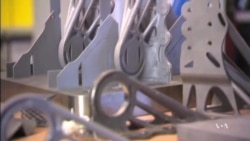By the end of this year, European aircraft manufacturing consortium Airbus plans to deliver the first of its new, extra-wide-body passenger jets, the A350-XWB. Among other technological innovations, the new plane will also incorporate metal parts made in a 3-D printer.
The high price of today’s air fares is due in large part to the cost of fuel, which is why manufacturers are striving to build lighter planes, with more efficient engines and more seats.
The bodies of modern jets, like Boeing’s 787 Dreamliner, are made from composite materials, usually carbon-reinforced plastic.
Some plastic parts created in a 3-D printer are already incorporated into the Airbus A350 jet. But the new model XWB will be the first with parts printed with titanium. Airbus emerging technologies manager Peter Sander says technicians learned to print even geometrically very complex shapes.
“Normally this is a part of the fuel system, it's two pipes in one, and it's normally welded out of 10 parts," he said. "So in this case, with 3-D printing we have the chance to integrate the bracket of the pipe and two pipes at once and print it in one shot.”
3-D printing is also a solution when parts are no longer available. Sander says when Airbus engineers needed a discontinued spare part for seats, it was easy to print perfect copies.
“So we did a redesign in a week and printing in a week. So the redesign itself cost two hours, we took the manual drawing, redesigned it and put it on the desk one week later to the spare part guys,” he said.
The technology is developing rapidly and one can easily imagine entire aircraft assembled out of printed parts.
Airbus executive Axel Krein says it will take a long time, but notes that in the meantime, the number of printed parts will keep increasing.
“We are investing a lot of money in aerodynamic improvement, in material, in noise reduction, etc., but 3-D printing is probably the area with the highest gain over time,” he said.
As a sign of things to come, the giant U.S. conglomerate General Electric says it is investing $50 million in a plant that will print fuel nozzles for its aircraft engines.






